Blood Clot in Brain: Types, Reasons & Treatment
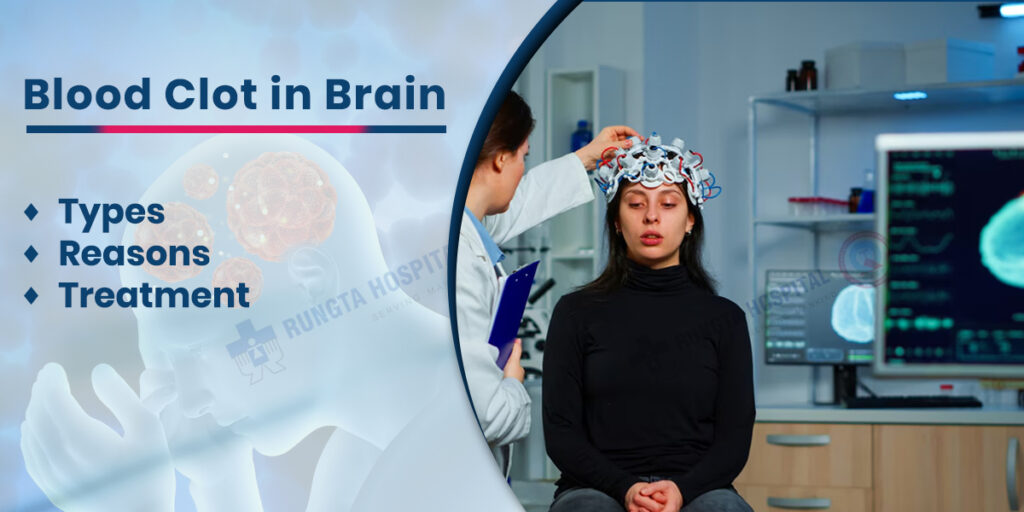
Book An Appointment A normal human body is likely to get infected with diseases every now and then. However, a healthy lifestyle including proper diet and exercise can help anyone live an active life. A sedentary lifestyle, following same dull routine, and improper food habits can lead to many problems such as diabetes, high blood pressure, and obesity. These problems can put you at risk of improper blood circulation and formation of blood clot in brain. We, at Rungta Hospital encourage people to follow an active lifestyle to avoid such situation. Through our regular medical campaigns, we ensure that people get enough knowledge to prevent it and to self-diagnose any early signs of blood clots. We have the best neurologist in Jaipur to help you with any such concerns. What Is Blood Clot in Brain? A brain clot occurs when a blood clot blocks the vessel supplying blood to the brain. The clot further stops nutrient and oxygen flow leading to death of the brain cells. This cell damage causes several serious neurological problems and in some cases death. It is essential that the symptoms are diagnosed at the right time to save and treat the patient. Blood clot in brain symptoms include severe headaches, difficulty in speaking, confusion, weakness, and improper vision. Rungta hospital provides the best treatment for neurological problems. Let’s read the about the types of blood clot in brain, the reasons behind it, and its treatment. You can read also:- Your Complete Guide on Hernia: Causes, Treatments, and Recovery Types of Blood Clots in Brain There are majorly two types of blood clots in brain which are Ischemic stroke and Hemorrhagic stroke. The third type is rarely found but exists namely Cerebral Venous Thrombosis (CVT). Ischemic StrokeThis type of stroke is most common in patients and occurs when a blood clot present in vessels restricts the blood flow to the brain. There are two types of Ischemic stroke:Thrombotic Stroke: This type of stroke occurs when a blood clot is formed in one of the arteries supplying blood to the brain. It is known to develop because of atherosclerosis, a condition caused as result of fatty deposition. Embolic Stroke: In this type, a blood clot in brain forms away from the brain, most commonly in the heart. This clot reaches the narrower brain arteries through the bloodstream. It may be caused a result of heart conditions like atrial fibrillation. Hemorrhagic StrokeThis type of stroke occurs when a blood vessel gets burst in brain leading to bleeding. There are two types of Hemorrhagic strokes.Intracerebral Hemorrhage: This is the condition when the blood vessel bursts in the brain leading to bleeding with the brain tissue. This is caused by high blood pressure or trauma. Subarachnoid Hemorrhage: This is the condition in which the bleeding occurs in the space lying between the brain and the tissues covering it. This is may be caused due to a ruptured aneurysm. Cerebral Venous Thrombosis (CVT)This rare stroke may occur as a result of a blood clot formed in the brain’s venous sinuses preventing the blood to drain out of the brain. This situation leads to an increased intracranial pressure causing brain damage. Reasons for Blood Clot in Brain There are numerous reasons behind the formation of a blood clot in brain. The best neurologist in Jaipur at Rungta Hospital is experienced and famous for timely diagnosing the symptoms and finding reasons behind its cause. Heart Conditions: There are different heart conditions which increase the risk of brain strokes. Heart attack can cause damage to the heart muscles creating conditions leading to clot formation. The other cause may be patent foramen ovale, a hole which didn’t close properly after birth leading clots to pass to the brain. Atrial Fibrillation or the irregular heartbeat can cause the blood to clot in heart and reach the brain. Smoking: Smoking is highly injurious to human body as the chemicals present in cigarettes is likely to promote blood clots. Diabetes: High level of blood sugar can damage blood vessels and increase the formation of blood clot in brain. Atherosclerosis: This condition includes the buildup of fatty deposits in the arteries known as plaques which are responsible for narrowing them. This leads to the creation of blood clots blocking the flow back to brain. Obesity: The excess weight in our body increases the risk of diabetes, atherosclerosis, and high blood pressure leading to blood clot formation. High Blood Pressure: This is one of the main causes of blood vessel damage making them more vulnerable to clotting and rupture. Sedentary Lifestyle: Regular exercising is important as lack of it increases blood clots, high blood pressure, obesity, and other issues. Genetic Reasons: If there is a family history of strokes and clots then it increases the risk in the younger members as well. Trauma: Head injuries can lead to blood vessel damage which can further cause blood clots in brain. Medication Side Effects: There are certain medicines including birth control pills that can increase the risk of blood clotting. Cancer and Its Treatment: There are some cancers and their treatment which may be responsible for increasing the risk of blood clot formation in brain. Prevention and Treatment for Blood Clot in Brain As it is said that “Prevention is better than cure”, it is better that we put in efforts on time to live a healthy life. Blood clot in brain can be prevented by making lifestyle changes and proper management of risk factors. For ex, if a person has high blood pressure, then he must regularly monitor and take medicines on time to maintain a healthy range. Similarly, a person with diabetes must control sugar levels through diet, medicines, and exercising. It is important that every person maintains his/her weight by exercising regularly, having a balanced diet and quitting smoking and drinking alcohol. Treatment at Rungta Hospital – The Best Neurology Hospital in Jaipur There are different ways of blood clot in brain treatment, it depends on the patient’s
How to Identify and Treat Kidney Infections Effectively?
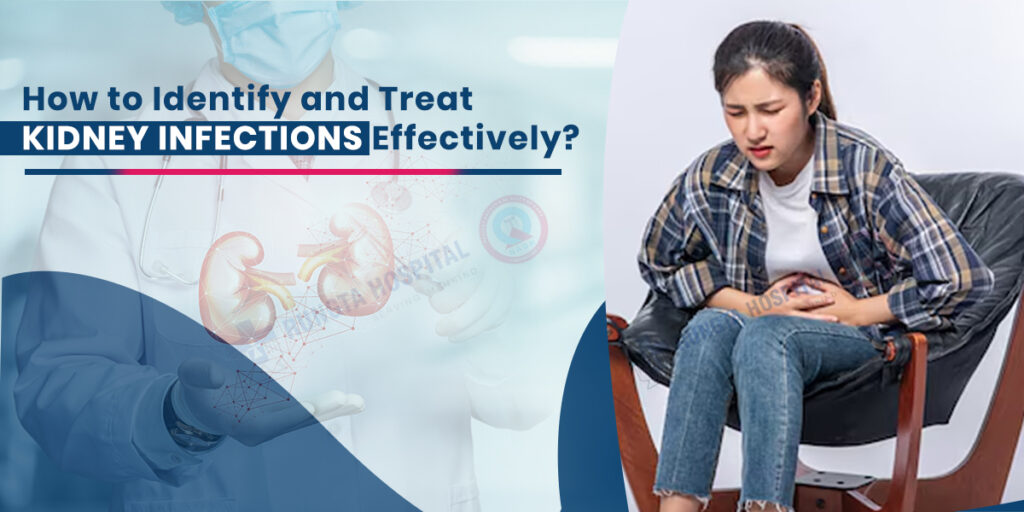
Book An Appointment You suddenly experience an intense, persistent pain in your lower back. You dismiss it as muscle pain probably caused due to your hectic lifestyle. But soon you realise that there is something more serious happening. High fever, pain and frequent urination. We are prone to dismiss our pain or self-treat ourselves ignoring the symptoms of conditions like kidney infection. Kidney infections are a serious health concern that can impact anyone. Understanding the causes, symptoms, and treatment options is essential for timely and effective care. What is a Kidney Infection? A kidney infection, or pyelonephritis, is a type of urinary tract infection (UTI) that begins in the bladder or urethra and travels up into the kidneys. The kidneys are two vital organs located on either side of your spine, just below your rib cage. They play a crucial role in filtering waste from your blood and regulating various bodily functions, including fluid balance and blood pressure. When bacteria enter the kidneys, they can cause an infection that leads to inflammation and pain. Kidney infections can affect one or both kidneys and, if not treated promptly, can result in serious health complications. The symptoms can be quite severe, making it essential to understand what a kidney infection is and how it can affect your overall health. Let us discuss the causes, symptoms, and treatment options for kidney infections, providing you with a comprehensive understanding of this condition. You can read also:- Your Complete Guide on Hernia: Causes, Treatments, and Recovery What are the main causes of a kidney infection? Kidney infections usually start as a urinary tract infection (UTI) that spreads to the kidneys. The most common culprit behind these infections is bacteria, particularly a type called Escherichia coli (E. coli). This normally lives in your intestines but can cause infection when it enters the urinary tract. Some of the primary causes of kidney infections are: Bacterial Infection: The most frequent cause of kidney infection is bacteria entering the urinary tract through the urethra and multiplying. This often begins as a bladder infection (cystitis) and can move up to the kidneys. Blockages in the Urinary Tract: Any blockage that prevents urine from flowing normally increases the risk of a kidney infection. This includes kidney stones, an enlarged prostate in men, or certain genetic abnormalities in the urinary tract. Weakened Immune System: People with weakened immune systems, such as those with diabetes or HIV, or those taking immunosuppressant medications, are more prone to kidney infections. Urinary Catheters: Long-term use of urinary catheters can introduce bacteria into the urinary tract, leading to infection. Female Anatomy: Women are more likely to get kidney infections than men due to their shorter urethra, which makes it easier for bacteria to reach the bladder and kidneys. Understanding these causes can help you take preventative measures and seek timely medical attention if you suspect an infection. What symptoms should you look out for in a kidney infection? Identifying the symptoms of a kidney infection early can lead to prompt treatment and prevent complications. Some of the common symptoms to watch for are: High Fever: One of the most telling signs of a kidney infection is a high fever. It is often accompanied by chills and shaking. Back or Side Pain: Pain on one side of your back or under your ribs can indicate a kidney infection. This pain can be sharp and intense or a constant, dull ache. Frequent Urination: Feeling the need to urinate more often than usual. if only a small amount of urine is passed each time, it is a common symptom. Painful Urination: A burning sensation during urination can signal a kidney infection. Carefully notice if it is accompanied by other symptoms mentioned here. Cloudy or Bloody Urine: Urine that appears cloudy, has an unusual odour, or contains blood can be a sign of a kidney infection. Nausea and Vomiting: Some people with kidney infections experience nausea and vomiting. It further indicates the severity of the infection. Fatigue: Feeling unusually tired or fatigued is another symptom, as the body is working hard to fight off the infection. If you experience any of these symptoms, it’s important to seek medical attention promptly. Early treatment can prevent the infection from worsening and causing serious health issues. You can consult expert urologists at Rungta Hospital for immediate and effective treatment of Kidney Infection. They can help you understand the symptoms, derive the probable causes and even recommend the best possible treatment. How is a Kidney Infection Diagnosed? Diagnosing a kidney infection involves a combination of medical history, physical examination, and diagnostic tests. Medical History and Symptoms: The expert doctors at Rungta Hospital will start by asking about your current symptoms and medical history. These may include any recent urinary tract infections, fever, or pain. Physical Examination: A physical exam will often focus on your abdomen and lower back to check for tenderness or pain, which can indicate a kidney infection. Urinalysis: A urine sample is typically taken to test for the presence of bacteria, blood, or pus. This test helps in confirming the presence of an infection and identifying the specific type of bacteria causing it. Urine Culture: If a urinalysis indicates an infection, a urine culture may be performed to pinpoint the exact bacteria and determine the most effective antibiotics for treatment. Blood Tests: It is important to identify if the bacteria has spread to the bloodstream. It can cause a serious condition known as septicemia. Imaging Tests: In some cases, imaging tests such as an ultrasound, CT scan, or MRI may be needed to get a detailed view of the kidneys and urinary tract. These tests can identify blockages, abscesses, or other abnormalities that might cause the infection. What are the Treatment Options for a Kidney Infection? Treating a kidney infection typically involves antibiotics and supportive care. However, the exact approach can vary depending on the severity of the infection. Some common treatment options include: Antibiotics: The primary treatment for kidney infections
Understanding the basic differences between Heart Attack Vs Heart Failure?
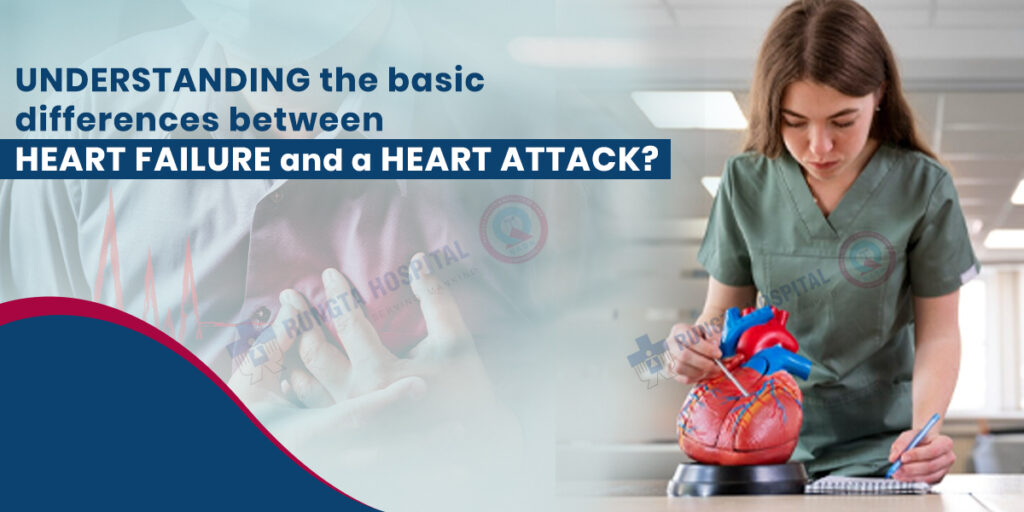
Book An Appointment When it comes to heart health, understanding the difference between heart failure and a heart attack is vital. Both conditions are serious and potentially life-threatening, but they affect the heart in distinct ways and require different treatments. You’re living your life as usual when suddenly, you experience severe chest pain or persistent fatigue. These symptoms could indicate a heart problem, but is it heart failure or a heart attack? Knowing the difference can save your life or the life of someone you love. Let’s unravel the complexities of these two conditions and the best care for both. What is Heart Failure? Heart failure, often referred to as congestive heart failure, is a condition where the heart can’t pump blood as well as it should. This doesn’t mean the heart has stopped working, rather, it means the heart is struggling to supply the body’s needs. Think of it like a pump that’s losing its power – it can still move water, but not as efficiently as before. Heart failure can develop over time due to various reasons- High blood pressure, coronary artery disease, and diabetes are common culprits. When the heart muscles are weakened or stiffened by these conditions, they can’t pump blood effectively. As a result, blood and fluids can back up into the lungs and other parts of the body, causing symptoms like shortness of breath, persistent coughing, fatigue, and swelling in the legs and ankles. You can read also:- Your Complete Guide on Hernia: Causes, Treatments, and Recovery What is a Heart Attack? A heart attack, or myocardial infarction, is a sudden event that occurs when blood flow to a part of the heart muscle is blocked. This blockage is usually caused by a blood clot that forms in a coronary artery, which supplies blood to the heart. Heart attacks are often triggered by the buildup of plaque in the arteries, known as atherosclerosis. When a plaque ruptures, it can cause a clot to form, blocking the artery and preventing blood from reaching parts of the heart. This lack of oxygen-rich blood can cause severe chest pain, shortness of breath, and other symptoms like nausea, lightheadedness, or discomfort in the arms, back, neck, or jaw. Causes of Heart Failure Heart failure can stem from various underlying conditions and lifestyle factors, including: High Blood Pressure (Hypertension): Persistent high blood pressure forces the heart to pump harder, causing it to weaken over time. Coronary Artery Disease: Narrowing or blockage of the coronary arteries restricts blood flow to the heart muscle, leading to damage. Diabetes: High blood sugar levels can damage the blood vessels and the heart muscle itself, increasing the risk of heart failure. Previous Heart Attack: A heart attack can weaken the heart muscle, reducing its ability to pump blood effectively and causing a reoccurrence. Heart Valve Disease: Malfunctioning heart valves can lead to abnormal blood flow, putting stress on the heart. Cardiomyopathy: Diseases of the heart muscle, such as hypertrophic cardiomyopathy or dilated cardiomyopathy, can impair heart function. Congenital Heart Defects: Structural abnormalities present at birth can affect the heart’s ability to pump blood. Arrhythmias: Irregular heart rhythms can weaken the heart muscle over time. Identifying the specific causes of heart failure in a patient and addressing the underlying factors is necessary. Rungta Hospital specialises in such tailored treatment plans. You can read also:- Prostate Problems Decoded: Untangling Causes, Solutions, and Myths Causes of Heart Attack A heart attack, or myocardial infarction, occurs due to a sudden blockage of blood flow to the heart. Common causes of heart attack include: Coronary Artery Disease: Accumulation of plaque (atherosclerosis) in the coronary arteries can rupture and form a clot, blocking the blood flow to the heart. High Cholesterol: Elevated levels of LDL cholesterol can contribute to the buildup of plaque in the arteries. Smoking: Tobacco use damages the lining of blood vessels, making them more susceptible to plaque buildup and clot formation. High Blood Pressure: Chronic hypertension increases the workload on the heart and can lead to the development of coronary artery disease. Obesity: Excess weight can contribute to conditions like diabetes and high blood pressure, which act as risk factors for heart attack. Diabetes: Uncontrolled diabetes increases the risk of atherosclerosis and coronary artery disease. Family History: Genetics can play a role in putting individuals at risk of early coronary artery disease and heart attacks. Physical Inactivity: Lack of regular exercise can contribute to obesity, high blood pressure, and other risk factors for heart attack. However, through comprehensive cardiac assessments and lifestyle counselling, these can be prevented easily. Thus at Rungta Hospital we not only provide treatment but also counseling on adopting heart-healthy habits and managing their cardiovascular health. Symptoms: Heart Failure vs. Heart Attack While both heart failure and heart attacks involve the heart, their symptoms can differ. Heart failure symptoms include chronic fatigue, persistent coughing, and swelling in the lower extremities. In contrast, heart attack symptoms are typically more acute and include intense chest pain, shortness of breath, and sudden dizziness. Symptoms Heart Failure Heart Attack Common Symptoms – Shortness of breath – Chest pain or discomfort – Fatigue – Shortness of breath – Swelling in legs, ankles, or abdomen – Nausea or vomiting – Persistent coughing – Sweating Less Common Symptoms Rapid or irregular heartbeat – Pain or discomfort in one or both arms, back, neck, jaw, or stomach – Reduced ability to exercise – Feeling of fullness, indigestion, or choking sensation – Dizziness or lightheadedness – Pain that radiates from the chest to the shoulders, arms, or neck – Confusion or impaired thinking – Sudden weakness or fatigue Emergency Symptoms – Sudden severe shortness of breath – Sudden, intense chest pain that lasts more than a few minutes – Chest pain or pressure accompanied by sweating, nausea, or lightheadedness – Sudden shortness of breath – Fainting or loss of consciousness – Loss of consciousness or collapse Treatments of Heart Failure Treatment of heart failure typically involves a combination of medications, surgical interventions,
Exploring the 10 Most Common Types of Orthopedic Surgery
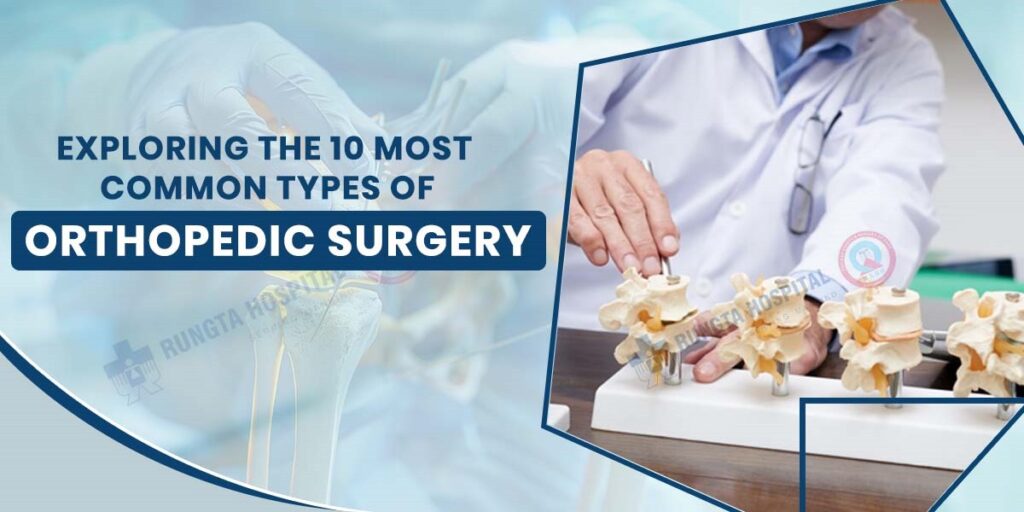
Book An Appointment Introduction Orthopedic surgery, a branch of surgery concerned with conditions involving the musculoskeletal system, stands as a cornerstone of modern medical practice. Renowned for restoring function and improving quality of life, orthopedic surgery addresses many issues, from fractures and dislocations to complex conditions like arthritis and spinal disorders. Technology advancements, such as minimally invasive techniques and robotic-assisted surgery, have significantly enhanced outcomes, reducing recovery times and improving precision. In today’s world, where an active lifestyle is highly valued and an aging population presents increasing musculoskeletal challenges, orthopedic surgery’s role is more crucial than ever. This field not only alleviates pain and enhances mobility but also enables individuals to return to their daily activities and enjoy a better quality of life. In this exploration, we will delve into the ten most common orthopedic surgeries, highlighting their importance and the conditions they address, shedding light on the transformative impact of these procedures on patients’ lives. 10 Common Types of Orthopedic Surgery Orthopedic surgeries address various conditions to restore function and alleviate pain. Here are details about common orthopedic surgeries: 1. Total Joint Replacement Surgery: Total Joint Replacement Surgery, often performed on the hip and knee, is a procedure where a damaged joint is replaced with a prosthetic implant. This surgery is commonly indicated for patients suffering from severe arthritis, particularly osteoarthritis, rheumatoid arthritis, or post-traumatic arthritis. These conditions cause the cartilage in the joints to wear away, leading to pain, stiffness, and reduced mobility. Advances in prosthetic materials and surgical techniques have significantly improved the longevity and functionality of joint replacements, allowing patients to regain pain-free movement and a better quality of life. Minimally invasive approaches and enhanced recovery protocols have also reduced hospital stays and accelerated rehabilitation. 2. Arthroscopic Surgery: Arthroscopic Surgery is a minimally invasive procedure used to diagnose and treat joint problems. Commonly performed on the knee, shoulder, elbow, and wrist, this surgery involves inserting a small camera (arthroscope) into the joint through a tiny incision, allowing surgeons to view, diagnose, and treat issues such as torn cartilage, ligaments, or inflamed synovial tissue. Conditions like meniscal tears, rotator cuff injuries, and labral tears are frequently addressed with arthroscopy. The major advantages of arthroscopic surgery include smaller incisions, reduced pain, shorter recovery times, and lower risk of infection compared to traditional open surgery. Continuous advancements in arthroscopic equipment and techniques have made this a preferred method for many joint surgeries. You Can Read also:- Exploring the 10 Most Common Types of Orthopedic Surgery 3. ACL Reconstruction: ACL Reconstruction is a procedure to repair a torn anterior cruciate ligament (ACL) in the knee. This injury is prevalent among athletes participating in high-impact sports such as soccer, basketball, and skiing, where sudden stops or changes in direction are common. A torn ACL can cause knee instability, pain, and a decreased range of motion. During the surgery, the torn ligament is replaced with a tendon graft, either from the patient (autograft) or a donor (allograft). Innovations in surgical techniques, such as the use of arthroscopy, have improved the precision and effectiveness of ACL reconstructions. Rehabilitation protocols have also advanced, focusing on early movement and strengthening to expedite recovery and return to sport. These improvements have led to better outcomes, allowing athletes to resume their activities with restored knee stability and function. 4. Rotator Cuff Repair: Rotator cuff repair is a common orthopedic procedure aimed at fixing tears in the rotator cuff tendons of the shoulder. These tendons can become damaged due to acute injuries or chronic wear and tear, leading to pain, weakness, and limited shoulder mobility. Rotator cuff injuries are particularly prevalent among athletes and individuals engaged in repetitive overhead activities. The surgery involves reattaching the torn tendon to the head of the humerus bone, often using minimally invasive arthroscopic techniques. Advances in surgical methods, such as the use of biologic grafts and improved suture materials, have significantly enhanced success rates and reduced recovery times. Patients typically experience a substantial reduction in pain and a marked improvement in shoulder function, allowing them to return to their normal activities and sports. 5. Spinal Fusion Surgery: Spinal fusion surgery is performed to stabilize the spine and alleviate chronic back pain caused by conditions such as degenerative disc disease, spondylolisthesis, and severe scoliosis. The procedure involves joining two or more vertebrae together using bone grafts, metal rods, and screws, which prevents motion between the fused segments and reduces pain stemming from spinal instability. Recent advancements in spinal fusion techniques, including minimally invasive approaches and the use of biologically enhanced materials, have improved outcomes and minimized complications. These improvements have led to shorter hospital stays, quicker recoveries, and better long-term results. Patients often report significant pain relief and improved mobility post-surgery, allowing for a better quality of life and increased ability to perform daily activities. 6. Carpal Tunnel Release: Carpal tunnel release surgery is aimed at relieving the symptoms of carpal tunnel syndrome, a condition caused by compression of the median nerve as it travels through the wrist. This compression leads to numbness, tingling, and weakness in the hand and fingers, often affecting those who perform repetitive hand movements, such as typing or assembly line work. The surgical procedure involves cutting the transverse carpal ligament to relieve pressure on the median nerve. Advances in surgical techniques, particularly endoscopic methods, have made the procedure less invasive, reducing recovery times and postoperative discomfort. Patients typically experience a rapid improvement in symptoms, regaining hand strength and function, which significantly enhances their ability to perform everyday tasks and improves their overall quality of life. 7. Meniscus Repair: Meniscus repair is a common orthopedic procedure aimed at treating tears in the meniscus, a crucial cartilage in the knee that acts as a shock absorber between the thigh and shin bones. Meniscus tears often result from sports injuries or aging-related degeneration, leading to pain, swelling, and limited knee mobility. The surgical repair of the meniscus involves stitching the torn pieces together to restore normal function and stability to
Knee Replacement: Surgery Details, Cost & Recovery
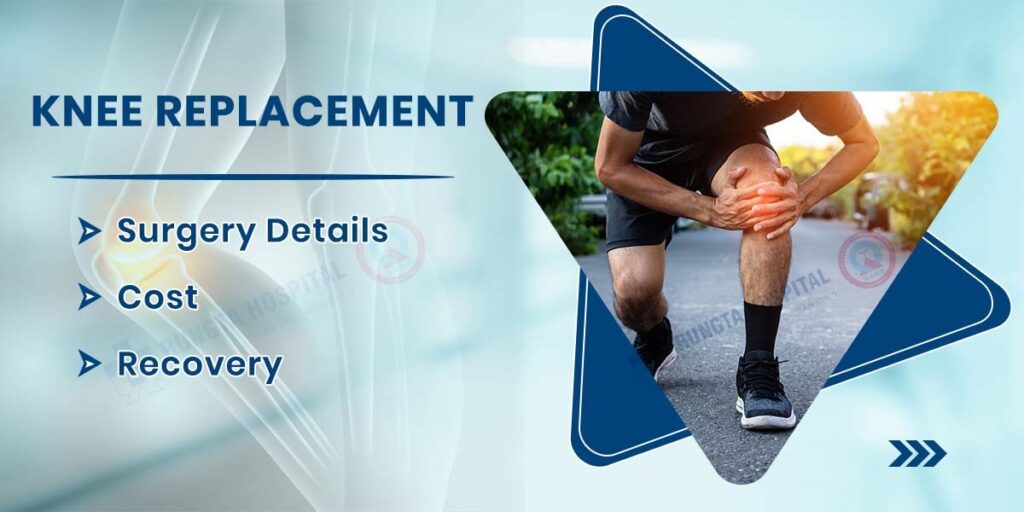
Book An Appointment What is Knee Replacement Knee replacement, also known as knee arthroplasty, is a surgical procedure to relieve pain and restore function in severely damaged knee joints. This procedure is typically recommended for individuals with advanced arthritis or other conditions that cause significant pain, stiffness, and limited mobility in the knee. During knee replacement surgery, the damaged portions of the knee joint are removed and replaced with artificial implants made of metal, plastic, or a combination of both. These implants mimic the function of a healthy knee joint, allowing for smoother movement and reduced discomfort. Knee replacement surgery can significantly improve the quality of life for individuals suffering from debilitating knee conditions, enabling them to resume activities they once enjoyed with greater ease and comfort. However, like any surgical procedure, knee replacement carries certain risks and requires a period of rehabilitation to achieve optimal outcomes. Knee Replacement Surgery Knee replacement surgery, also known as knee arthroplasty, involves several key steps: Preparation: Before the surgery, the patient will undergo a thorough evaluation, including a medical history review, physical examination, and often imaging tests such as X-rays or MRI scans. Blood tests may also be conducted to ensure the patient is in good overall health for surgery. Anaesthesia: The patient will receive either general anaesthesia (where they are unconscious) or regional anaesthesia (such as a spinal or epidural block) to numb the lower body while remaining conscious. Incision: Once the anaesthesia takes effect, the surgeon makes an incision over the knee joint, typically along the front or side of the knee. Reshaping the Bones: The damaged or diseased portions of the knee joint are carefully removed. This includes reshaping the ends of the thigh bone (femur) and shin bone (tibia) to accommodate the artificial implants. Implant Placement: The surgeon then positions the artificial implants. These typically consist of metal components for the femur and tibia, along with a plastic spacer to provide a smooth surface for movement between the metal components. Sometimes, the kneecap (patella) may also be resurfaced with a plastic component. Closure: Once the implants are securely placed, the surgeon closes the incision with sutures or staples and applies dressings to protect the wound. Recovery: After surgery, the patient is taken to a recovery area where they are monitored closely as they wake up from anaesthesia. Pain management medications are administered as needed to keep the patient comfortable. Physical Therapy: Rehabilitation is a crucial part of the recovery process. Physical therapists work with the patient to regain strength, mobility, and flexibility in the knee joint. This typically involves exercises to improve range of motion, strength training, and activities to improve balance and coordination. Post-operative Care: The patient may need to use assistive devices such as crutches or a walker for some time following surgery. They will also need to attend follow-up appointments with their surgeon to monitor healing and progress. You can read also:- Your Complete Guide on Hernia: Causes, Treatments, and Recovery Knee Replacement Surgery cost The cost of knee replacement surgery in India can vary depending on several factors such as the city where the surgery is performed, the hospital or medical facility chosen, the surgeon’s expertise, the type of implants used, and any additional medical services or amenities provided. Rungta hospital offers these surgeries free under RGHS, CGHS & Chiranjeevi schemes, you can take advantage of these scheme through rungta hospital for knee replacement surgery. This cost typically covers expenses such as hospital stays, surgeon’s fees, anaesthesia, implants, medications, pre-operative tests, and post-operative rehabilitation. However, it’s important to note that these are rough estimates, and actual costs may vary. Patients are advised to consult with healthcare providers or hospitals directly to get accurate pricing information based on their specific needs and circumstances. Additionally, some hospitals may offer package deals or discounts, especially for international patients. Knee Replacement Surgery Recovery The recovery process following knee replacement surgery typically involves several stages: ● Hospital Stay: Most patients remain in the hospital for 1 to 3 days after knee replacement surgery. During this time, they receive pain management medication, antibiotics to prevent infection, and physical therapy to help regain mobility in the knee joint. ● Pain Management: Pain and discomfort are common after surgery, but medications prescribed by the surgeon can help manage this. As the recovery progresses, pain typically decreases gradually. ● Mobility and Weight-Bearing: Initially, patients may need assistance with walking and may use crutches, a walker, or a cane. Physical therapists guide how to safely bear weight on the knee and gradually increase mobility. ● Physical Therapy: Rehabilitation exercises are a crucial part of the recovery process. Physical therapists work with patients to improve range of motion, strength, and flexibility in the knee joint. Exercises may include gentle stretching, strengthening exercises, and activities to improve balance and coordination. ● Home Care: After discharge from the hospital, patients continue their recovery at home. They may need assistance with daily activities such as bathing, dressing, and meal preparation, especially during the first few weeks of recovery. ● Follow-up Appointments: Patients are typically scheduled for follow-up appointments with their surgeon to monitor healing and progress. During these appointments, the surgeon may perform physical exams, review X-rays, and adjust the treatment plan as needed. ● Gradual Return to Activities: While recovery times vary for each individual, most patients can expect to return to light activities such as driving and office work within 4 to 6 weeks after surgery. More strenuous activities such as sports or heavy lifting may be gradually resumed after several months, with guidance from the surgeon and physical therapist. ● Long-Term Care: Knee replacement surgery can provide long-lasting pain relief and improved function in the knee joint. However, patients need to continue with regular exercise, maintain a healthy weight, and follow any recommendations from their healthcare team to optimize long-term outcomes and minimize the risk of complications. You can read also:- Prostate Problems Decoded: Untangling Causes, Solutions, and Myths Conclusion Rungta Hospital in Jaipur is
Finding The Best Heart Specialist Doctor in Jaipur
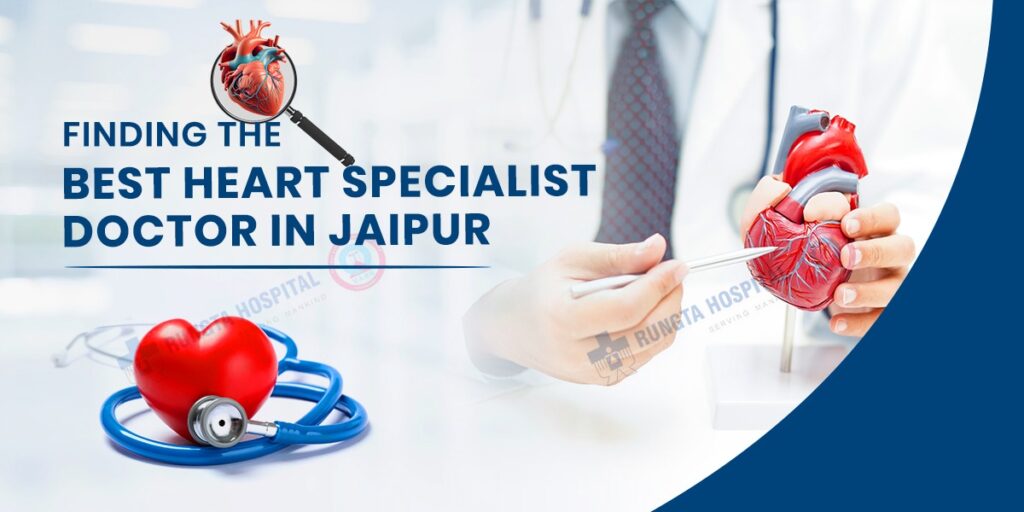
Free Tele Consultation At Rungta Hospital, we understand the importance of exceptional heart care. For over 33 years, we’ve been a leader in healthcare, serving over 10.6 million patients across India and beyond. Pioneering critical care services in Rajasthan, we were the first private hospital to offer mobile ICU and NICU. How to Find the Right Heart Specialist Doctor in Jaipur: 1)Experience Matters: Look for a cardiologist with a proven track record in diagnosing and treating heart conditions.2)Expertise is Key: Consider their area of specialization within cardiology. Do they focus on preventative care, interventional procedures like angioplasty, or electrophysiology?3)Patient Reviews Offer Insights: Read online reviews from previous patients to understand the doctor’s bedside manner, communication style, and overall patient experience.4) Convenience Counts: Accessibility is key. Consider factors like travel time and appointment availability. You can read also:- Prostate Problems Decoded: Untangling Causes, Solutions, and Myths Why Choose Rungta Hospital’s heart specialists for Your Heart Care Needs? At Rungta Hospital, we have a team of highly qualified and experienced heart specialist doctors – some of the best cardiologists in Jaipur. Each cardiologist has a proven track record of success and is dedicated to providing exceptional patient care. Our advanced cardiac care unit is equipped with cutting-edge technology to ensure the most accurate diagnosis and the most effective treatment plans. 1)Collaborative Care: Our cardiologists work closely with other specialists, like cardiac surgeons and anesthesiologists, to provide comprehensive care for all your heart health needs.2)Advanced Diagnostics: We offer a comprehensive range of diagnostic tests, including ECGs, echocardiograms, stress tests, and cardiac catheterizations.3) our heart specialists are trusted by patients as we have 4.8 star rating(9700+ reviews) 4) We have 24/7 cardiac care support which is essential in emergency Patient Testimonials My experience with Rungta’s cardiology department was excellent. The heart specialist doctor I saw was very knowledgeable and addressed all my concerns. Highly recommend! Ramesh VyasPatient If you’re looking for a cardiologist near me, look no further than Rungta Hospital! The staff is friendly and the doctors are top-notch. sonam Patient Thanks to Rungta’s cardiology team, I feel confident now because earlier I was bit stressed about my health because I had many heart problems but doctors in rungta hospital helped me a lot and their medicines worked like ramban for me. They are some of the best cardiologists in Jaipur prachi jainPatient I visited rungta hospital to consult a heart doctor. They gave full time and understood by problem. The treatment advised was also very good and I will surely say rungta hospital has best heart specialist in jaipur VishalPatient Related Blogs:
Your Complete Guide on Hernia: Causes, Treatments, and Recovery
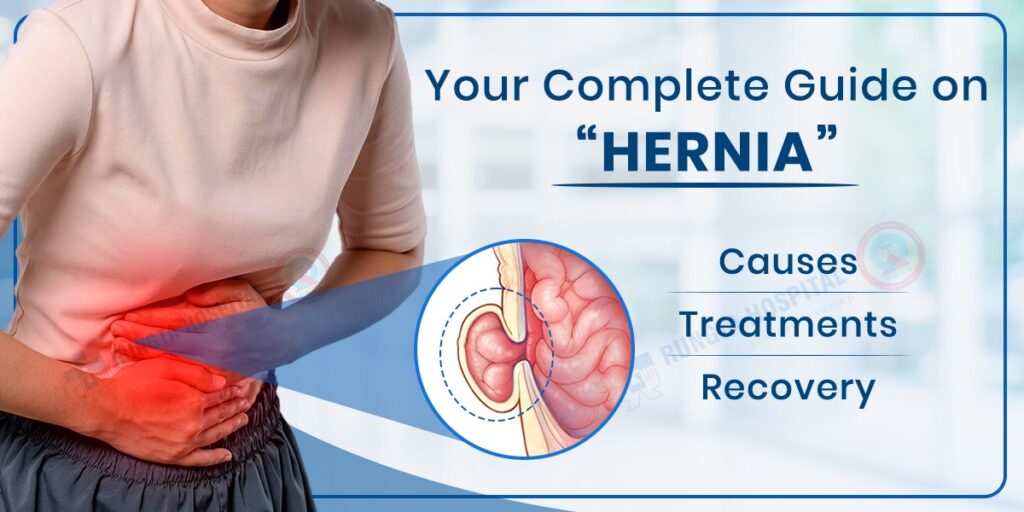
Book An Appointment Imagine waking up one morning, ready to tackle the day ahead, only to be stopped in your tracks by an unexpected pain in your abdomen. If that’s the case with you, fear not. You are not alone. Millions of people around the world suffer from hernias, but the good news is that there are effective treatments out there to help alleviate the discomfort and get you back on track. In this guide, we will walk you through everything you need to know about hernias – from understanding the causes and symptoms to exploring treatment options and recovery strategies. Understanding Hernias Let’s start with the basics. What exactly is a hernia? A hernia happens when an organ or tissue squeezes through a weak spot in the surrounding muscle or connective tissue. It’s similar to a tiny hole in your body’s defences that permits an opening that can cause anything from minor discomfort to excruciating pain. There are several types of hernias, each with its unique characteristics. It is essential to recognise the many forms of hernias for accurate diagnosis and treatment, ranging from groyne-related inguinal hernias to stomach-related hiatal hernias that entail the stomach pressing through the diaphragm. Causes of Hernias Now that we have a basic understanding of what hernias are, let’s delve deeper into what causes them. While hernias can be caused by a variety of factors, they often arise from a combination of weak muscles and increased pressure on certain areas of the body. Lifestyle choices also play a big role in hernia development. Activities like heavy lifting, persistent coughing, or struggling with constipation can strain the muscles in the abdomen, making hernias more likely to emerge. These activities weaken the muscles over time, increasing the likelihood of a hernia forming. Furthermore, genetics can also contribute to hernias. Some individuals may have a higher risk of developing hernias due to their family history. Recognising if hernias run in your family can help you take preventive measures and seek early treatment if needed. To put it simply, weakening muscles and increasing strain on specific body parts often lead to hernias. You can lower your risk of hernias and take precautions to preserve your general health by becoming aware of your lifestyle choices and being aware of your family history. Diagnosis Diagnosing a hernia generally involves a combination of medical history, physical examination, and periodically imaging tests. Your doctor will ask about your symptoms, perform a complete examination, and may recommend tests such as ultrasound or MRI to confirm the diagnosis. Early detection is critical when it comes to hernias, as they tend to worsen over time if left untreated. So if you suspect you may have a hernia, do not think twice about seeking medical attention. Treatment Options Treating hernias involves a range of options tailor-made to suit individual needs. Initially, conservative methods like changing lifestyle habits, such as refraining from heavy lifting or wearing supportive garments, may be recommended to clear symptoms and prevent further strain on weakened muscles. In cases where hernias cause continuous discomfort or pose risks of complications, surgical intervention may be necessary. Rungta Hospital offers a comprehensive range of treatment options, including different types of hernia surgeries. These surgeries seek to repair the weakened area and reinforce the surrounding muscles, effectively handling the underlying cause of the hernia. Your doctor will go over the advantages and disadvantages of each type of hernia surgery with you to decide which course of action is best for your particular situation. Modern methods carried out by experienced surgeons at Rungta Hospital guarantee the best possible results and a quick recovery, whether the surgery is minimally invasive or open. Rungta Hospital is one of the best hospital in Jaipur to assist you in regaining your health and well-being. It provides individualized care along with cutting-edge treatment choices. You can read also:- Prostate Problems Decoded: Untangling Causes, Solutions, and Myths Recovery Process Following hernia surgery, recovery calls for patience and commitment to post-operative care guidelines. This may involve putting limitations on particular activities and escalating physical activity gradually while being supervised by a medical expert. The majority of patients can anticipate returning to their regular activities in a matter of weeks to months, while the exact recovery period will depend on the type of operation and personal characteristics. Complications and Recurrence While hernia surgeries are mostly safe and successful, problems like infection or hernia recurrence are still possible. It’s critical to carefully follow your doctor’s instructions and show up for follow-up appointments when instructed to reduce these risks. Recurrence of the hernia can also be decreased by changing one’s lifestyle to include things such as maintaining a healthy weight and avoiding activities that put strain on the abdominal muscles. Lifestyle Modifications Aside from surgical treatments, simple lifestyle changes can greatly aid in managing and preventing hernias. A high-fibre diet lowers the risk of hernias and relieves abdominal strain by preventing constipation. Additionally, including exercises that target core muscles and promote good posture can strengthen abdominal muscles. It would provide better support for organs and reduce the likelihood of hernia occurrence. These lifestyle changes serve as proactive measures to maintain overall abdominal health and reduce the odds of hernia development. Support and Resources Dealing with a hernia can feel overwhelming, but you are not alone. There are many support groups and online communities where you can connect with others going through similar experiences. Plenty of educational materials and resources are available to help you better understand your condition and make informed decisions about your healthcare. You can read also:- Heart Bypass Surgery: Don’t Be Fooled by Myths! A Guide to Causes, Treatments, and Misconceptions Secure Your Health: Embrace a Hernia-Free Future In the end, hernias are a common but treatable condition that affects millions of people worldwide. By understanding the causes, symptoms, and treatment options, you can take proactive steps to manage your hernia and improve your quality of life. Remember that seeking professional advice and guidance
Prostate Problems Decoded: Untangling Causes, Solutions, and Myths
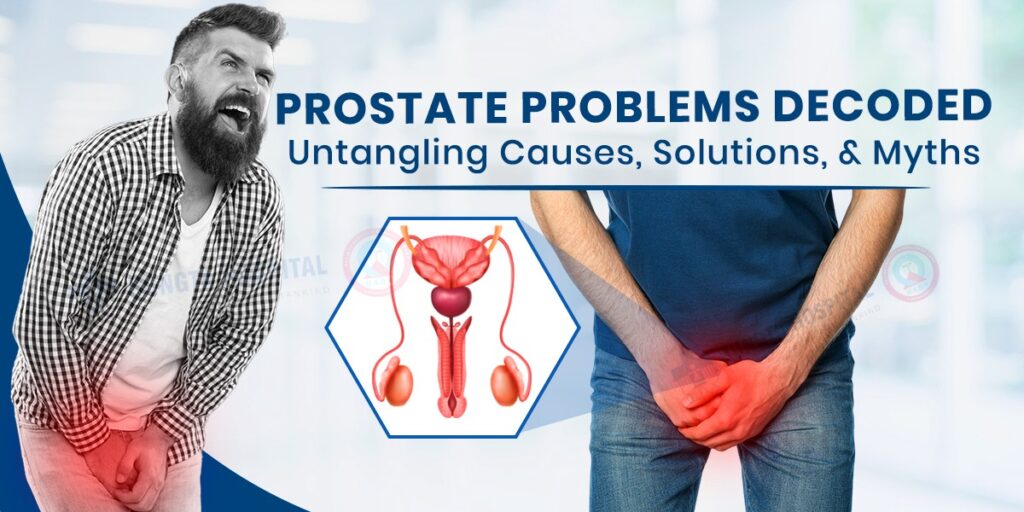
Book An Appointment Are you tired of feeling the urge to urinate every hour, disrupting your work and personal life? You’re not alone. Millions of men struggle with prostate problems, but there’s hope. In this guide, we’ll uncover the causes, treatments, and myths surrounding prostate health, empowering you to take control of your well-being once and for all. Understanding the Prostate Let’s start with the basics. The prostate is a small gland located just below the bladder and in front of the rectum in men. This walnut-sized gland plays a crucial role in male reproductive function. Its primary function is to produce seminal fluid that nourishes and transports sperm during ejaculation. As men age, the prostate can change, leading to different problems. One common condition is benign prostatic hyperplasia (BPH), characterised by the enlargement of the prostate gland, which can exert pressure on the urethra. It could lead to urinary symptoms such as frequent urination, nocturia, and weak urine flow. Additionally, the risk of developing prostate cancer increases with age, highlighting the significance of preventative measures like routine screenings and lifestyle changes to reduce this potential threat. By understanding the intricate functions and potential changes associated with the prostate, individuals can take proactive steps to safeguard their health and vitality throughout the years. Common Prostate Problems: Benign Prostatic Hyperplasia (BPH) This is the most common prostate problem among older men. BPH is denoted by an enlarged prostate gland, which can cause urinary symptoms such as frequent urination, difficulty starting or maintaining urination, and a weak urine stream. Although BPH is not cancerous and does not increase the risk of prostate cancer, its impact on urinary function requires medical attention and management strategies to alleviate symptoms and prevent complications. Prostatitis Prostatitis refers to inflammation of the prostate gland, which can be caused by bacterial infection or other factors. Symptoms may include pelvic pain, fever, persistent bacterial infections and more. CPPS, also known as chronic non-bacterial prostatitis, is the most common form of prostatitis and is described by pelvic pain, discomfort during urination, and urinary frequency, among other symptoms. Prostate Cancer Prostate cancer is the most serious prostate problem and is one of the most common cancers in men. Early detection is critical for successful treatment. Age, family history, ethnicity, and genetic predisposition are among the risk factors for prostate cancer that have been found, despite the fact the specific aetiology of the disease is still unknown. Depending on the stage and severity of the disease, treatment options for prostate cancer may include immunotherapy, targeted therapy, radiation therapy, hormone therapy, chemotherapy, and active surveillance. Causes of Prostate Problems While the exact causes of prostate problems are not entirely known, several factors may contribute to their emergence. These include age, family history, lifestyle choices such as diet and exercise, and certain medical conditions. Age Age is a significant determinant, as the prostate gland gradually ages. Cellular growth and hormonal changes can cause illnesses like prostate cancer or benign prostatic hyperplasia (BPH). Family History Another important factor is family history since genetic predispositions raise the risk of prostate problems. According to research, people with a family history of prostate issues, especially those who have a first-degree relative who has been diagnosed with prostate cancer, may be at a higher risk themselves. Lifestyle Choices Prostate health is influenced by lifestyle choices including food and exercise. Prostate issues have been linked to diets high in saturated fats and poor in fruits, vegetables, and fibre; however, prevention can come from regular exercise and a diet strong in antioxidants and nutrients. Medical Issues Furthermore, certain medical conditions, such as obesity, diabetes, and cardiovascular disease, have been associated with an increased risk of prostate issues. These disorders may put a person at risk for prostate issues by affecting their general systemic health, hormone balance, and inflammatory response. Prostate health can only be reduced by addressing these modifiable risk factors through lifestyle changes and preventative healthcare interventions, even though the exact mechanisms behind prostate problems are still being investigated. You Can read also:- Rotablation Angioplasty: Benefits, Purpose, Procedure, Treatment and Recovery Treatment Options The good news is that many prostate problems can be effectively managed with diverse treatment options. These may include: Medications For BPH and prostatitis, medications such as alpha-blockers, 5-alpha reductase inhibitors, and antibiotics may be prescribed by doctors to alleviate symptoms. Minimally Invasive Procedures In cases where medications are ineffective, minutely invasive procedures such as transurethral resection of the prostate (TURP) or laser prostate surgery could be recommended. Surgery For prostate cancer or severe cases of BPH, surgery may be necessary. Traditional prostate surgery involves removing part or all of the prostate gland. However, laser holmium prostate surgery is a newer, more advanced technique that offers several advantages over traditional surgery. Difference between Normal Prostate Surgery and Laser Holmium Prostate Surgery When it comes to treating prostate problems, the choice between traditional surgery and laser holmium prostate surgery can make a substantial difference in outcomes and patient experience. Traditional prostate surgery generally involves cutting and removing tissue from the prostate gland, which can lead to quite a bit of bleeding, longer hospital stays, and a prolonged recovery period. On the other hand, laser holmium prostate surgery, also known as holmium laser enucleation of the prostate (HoLEP), offers a minimally invasive approach. This advanced technique utilises laser technology to specifically vaporise excess prostate tissue, resulting in less bleeding, shorter hospital stays, and faster recovery times compared to traditional surgery. Furthermore, laser holmium prostate surgery provides better preservation of surrounding healthy tissue, minimising the risk of complications and improving overall patient satisfaction. Rungta Hospital is proud to offer this state-of-the-art treatment option to our patients, ensuring the best possible outcomes with minimal discomfort and downtime. You can read also:- Heart Bypass Surgery: Don’t Be Fooled by Myths! A Guide to Causes, Treatments, and Misconceptions Debunking Myths Before we conclude, let’s address some common myths about prostate problems: 1. Myth: Only older men get prostate problems. Fact: While
Heart Bypass Surgery: Don’t Be Fooled by Myths! A Guide to Causes, Treatments, and Misconceptions
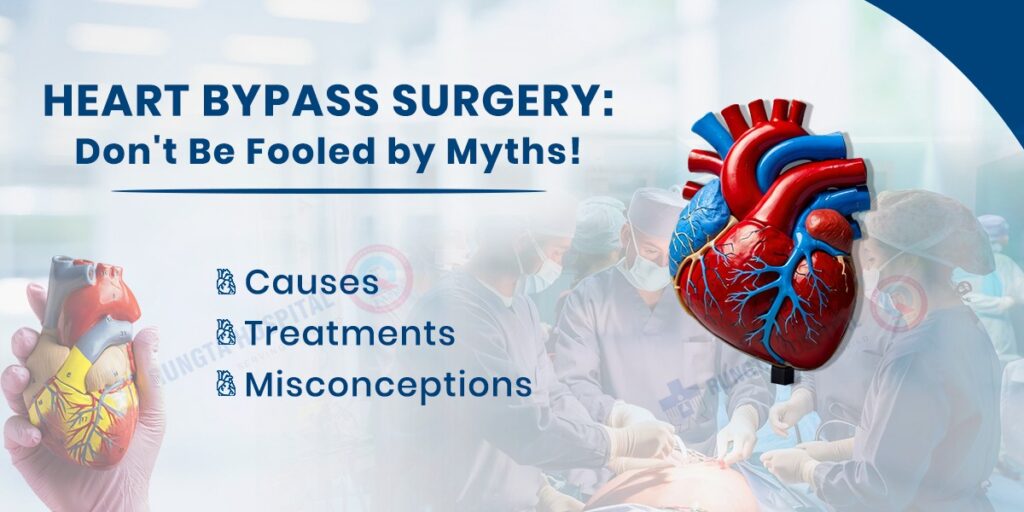
Book An Appointment Introduction: Heart Bypass Surgery stands as a vital procedure, frequently obscured by myths and misunderstandings. Within this all-encompassing guide, our objective is to dispel prevalent misconceptions surrounding this life-saving intervention. We illuminate the causes, treatments, and real-life experiences patients encounter throughout their journey with Heart Bypass Surgery. By furnishing a lucid overview of the procedure and tackling prevalent misconceptions head-on, we provide individuals with the knowledge to make informed decisions regarding their heart health. With this guidance, patients can navigate the path to recovery from Heart Bypass Surgery with confidence and clarity. What is heart bypass surgery? In medical terminology, “bypass” denotes the establishment of an alternate route for blood circulation when the regular pathway is obstructed or compromised. This term finds common usage in coronary artery bypass surgery, where a new pathway, known as the bypass graft, is crafted to bypass blockages or narrowings in coronary arteries. By circumventing the diseased segment of the artery, this surgical intervention restores adequate blood flow to the heart muscle, thereby alleviating symptoms and mitigating the risk of further complications. Heart bypass surgery also referred to as coronary artery bypass grafting (CABG), employs this principle to treat coronary artery disease. During the procedure, a surgeon creates a new path for blood flow around a blocked or narrowed artery, often utilizing a healthy blood vessel from elsewhere in the body or synthetic tubes. By facilitating improved blood flow to the heart muscle, this surgery alleviates symptoms like chest pain (angina) and diminishes the risk of heart attack. Why do we need Heart Bypass Surgery? The need for heart bypass surgery typically arises due to coronary artery disease (CAD), a condition characterized by the accumulation of plaque within the coronary arteries, which supply oxygen-rich blood to the heart muscle. Several factors contribute to the development and progression of CAD, including: Atherosclerosis: The buildup of fatty deposits, cholesterol, and other substances within the arterial walls, leading to plaque formation. Hypertension (high blood pressure): Elevated blood pressure can damage the inner lining of the arteries, making them more susceptible to plaque formation. High cholesterol: Elevated levels of LDL (“bad”) cholesterol and low levels of HDL (“good”) cholesterol can contribute to the development of plaque within the arteries. Diabetes: Individuals with diabetes are at an increased risk of developing CAD due to factors such as insulin resistance and abnormal lipid metabolism. Age: The risk of CAD increases with age, with older adults being more likely to develop significant blockages in their coronary arteries. Other medical conditions: Certain medical conditions, such as chronic kidney disease, inflammatory diseases, and autoimmune disorders, can increase the risk of CAD and the need for heart bypass surgery. Why Rungta Hospital Is Best For Heart Bypass Suurgery? Rungta Hospital excels in heart bypass surgery with 500 successful procedures annually, a seasoned team of cardiologists and surgeons boasting over 350,000 hours of experience, cashless surgery options, transparent pricing, and state-of-the-art facilities ensuring top-notch care for patients of all ages. How is bypass surgery done? Heart bypass surgery is a complex surgical procedure performed to restore adequate blood flow to the heart muscle by bypassing blocked or narrowed coronary arteries. Here’s an overview of the medical procedure: Preparation:○ The patient is administered general anesthesia to induce unconsciousness and ensure pain-free surgery.○ Monitors are placed to track vital signs such as heart rate, blood pressure, and oxygen levels throughout the procedure.○ The surgical team sterilizes the surgical site and covers the patient with sterile drapes to minimize the risk of infection. Accessing the Heart:○ The surgeon makes an incision in the chest, typically along the sternum (median sternotomy), to access the heart. Harvesting the Grafts:○ Healthy blood vessels, called grafts, are obtained from other parts of the body, such as the leg (saphenous vein) or the chest wall (internal mammary artery).○ If multiple grafts are needed, additional vessels may be harvested using minimally invasive techniques or by utilizing arteries from the forearm (radial artery) or the abdomen (gastroepiploic artery). Creating the Bypass:○ The surgeon attaches one end of each graft to the aorta (the main artery leaving the heart) and the other end to the coronary artery beyond the blockage or narrowing.○ This creates a new pathway for blood to bypass the obstructed portion of the coronary artery, allowing blood to flow directly to the heart muscle. Monitoring and Testing:○ During the entire procedure, the surgical team monitors the heart’s function using specialized equipment, such as echocardiography or intraoperative angiography.○ After creating the bypass grafts, the surgeon may test their functionality by temporarily stopping the heart (cardiopulmonary bypass) and observing blood flow through the grafts. Closure:○ Once the bypass grafts are in place and functioning properly, the surgeon closes the incision(s) using sutures or staples.○ Chest tubes may be inserted to drain excess fluid and air from the chest cavity, aiding in lung re-expansion and preventing complications such as pneumothorax (collapsed lung). Recovery:○ The patient is transferred to a recovery area, where they are closely monitored for signs of complications such as bleeding, infection, or cardiac arrhythmias.○ Pain management and supportive care are provided to ensure a comfortable recovery period. Heart bypass surgery is a major surgical intervention that requires careful planning, skilled execution, and comprehensive post-operative care to ensure optimal outcomes for patients. You Can read also:- Rotablation Angioplasty: Benefits, Purpose, Procedure, Treatment and Recovery Misconceptions about Heart Bypass Surgery These are some of the myths concerning bypass surgery. Only old people can undergo heart bypass surgery. There are significant risks associated with bypassing the heart and often complications result. After having a heart bypass surgery, one may require months or even more to completely heal. A person can only be operated on once in his/her lifetime through a procedure called coronary artery bypass graft (CABG) operation; otherwise, the patient will die Patients following an operation cannot return to leading their normal life again as before due to reduced physical activities and psychological fear of death. The vessels created during the
Rotablation Angioplasty: Benefits, Purpose, Procedure, Treatment and Recovery
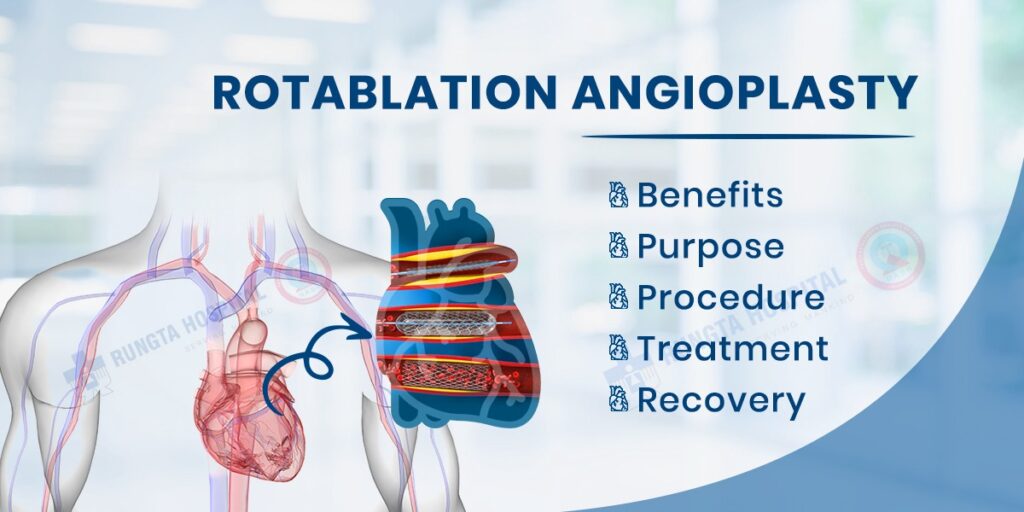
Book An Appointment Introduction: What is Rotablation Angioplasty? Rotablation angioplasty, a specialized form of percutaneous coronary intervention (PCI), offers a minimally invasive solution for treating severely calcified coronary arteries. This innovative procedure utilizes a high-speed rotational device equipped with a diamond-coated burr to gently abrade calcified plaque, allowing for smoother vessel expansion and improved blood flow. In this article, we will delve into the mechanism of rotablation angioplasty, its indications and contraindications, procedural steps, and potential complications. Moreover, we will explore the expertise of Rungta Hospital, renowned for its cutting-edge facilities and skilled medical professionals, in conducting successful rotablation procedures and providing comprehensive cardiac care. Benefits of Rotablation Angioplasty Rotational or Rotablation angioplasty is a procedure used to treat coronary artery disease (CAD), particularly when plaque buildup within the arteries restricts blood flow to the heart. Here are some of the benefits associated with Rotablation angioplasty: Effective plaque removal: Rotablation employs a tiny rotating burr at the tip of a catheter to grind away the plaque buildup within the arteries. This mechanical action effectively removes the hardened plaque, restoring blood flow through the artery. Precise treatment: Rotablation allows for precise treatment of complex lesions, including heavily calcified or fibrous plaques that may be difficult to treat with traditional balloon angioplasty alone. The rotational burr can penetrate and modify the toughest plaques, making it an effective option for cases where other methods may not be as successful. Reduced risk of complications: By effectively removing plaque from the artery walls, Rotablation angioplasty can reduce the risk of complications such as restenosis (re-narrowing of the artery) or dissection (tearing of the artery wall) compared to traditional angioplasty alone. Improved outcomes: Studies have shown that Rotablation angioplasty can lead to improved procedural success rates and better long-term outcomes for patients with complex coronary artery disease, including reduced rates of repeat interventions or the need for coronary artery bypass surgery. Minimally invasive: Like other forms of angioplasty, Rotablation is a minimally invasive procedure performed using catheters inserted through small incisions in the skin, usually in the groin area. This minimizes trauma to the body, reduces recovery time, and lowers the risk of complications compared to open-heart surgery. Customized treatment: Rotablation allows for customization of treatment based on the characteristics of the plaque and the anatomy of the patient’s arteries. The rotational burr comes in different sizes, allowing physicians to select the appropriate size for the specific lesion being treated, thus optimizing the results of the procedure. Preservation of vessel structure: Unlike some other treatment methods for heavily calcified plaques, Rotablation selectively removes the plaque while preserving the underlying vessel structure. This helps maintain the integrity of the artery, reducing the risk of complications such as vessel perforation or dissection. You Can read also:- Chapped Lips: Symptoms, Causes, Diagnosis, Treatment, and Prevention Purpose of Rotablation Angioplasty Rotablation angioplasty serves several purposes in the treatment of coronary artery disease (CAD): Plaque Removal: The primary purpose of Rotablation angioplasty is to remove plaque buildup within the coronary arteries. Plaque is made up of cholesterol, calcium, and other substances that can narrow or block the arteries, reducing blood flow to the heart muscle. Rotablation uses a rotating burr at the tip of a catheter to grind away the plaque, restoring blood flow and improving the function of the affected artery. Lesion Modification: In cases where traditional balloon angioplasty may be ineffective due to heavily calcified or fibrous plaques, Rotablation can modify the lesion, making it more amenable to further treatment. By breaking up calcifications and modifying the plaque, Rotablation can facilitate the successful deployment of stents or other devices to keep the artery open. Optimizing Stent Placement: Rotablation is often used in conjunction with stent placement to treat CAD. By preparing the artery with Rotablation before stent deployment, physicians can optimize stent expansion and apposition to the vessel wall, reducing the risk of complications such as stent malapposition or restenosis. Treatment of Complex Lesions: Rotablation is particularly useful in treating complex lesions, including those that are heavily calcified, tortuous, or located in difficult-to-reach areas of the coronary arteries. The rotational burr can penetrate and modify these lesions, allowing for successful treatment where other methods may be less effective. Improving Procedural Success Rates: By effectively removing plaque and modifying lesions, Rotablation angioplasty can improve procedural success rates and reduce the need for additional interventions. This can lead to better outcomes for patients with CAD, including reduced rates of restenosis and improved long-term prognosis. Procedure of Rotablation Angioplasty The procedure of Rotablation angioplasty involves several steps and is typically performed in a cardiac catheterization laboratory by a team of interventional cardiologists and specialized nurses. Here’s an overview of the procedure: Preparation: The patient is prepared for the procedure, which may involve taking medications, such as antiplatelet drugs, to prevent blood clots. The patient is positioned on an examination table, usually lying flat on their back. An intravenous (IV) line is inserted into a vein in the arm or hand to administer medications and fluids during the procedure. Local Anesthesia: The insertion site, typically in the groin or wrist, is cleaned and numbed with a local anesthetic. A small incision is made at the insertion site to access the artery. Guidewire Insertion: A thin, flexible guidewire is inserted into the artery through a sheath (a small tube) placed at the insertion site. The guidewire is carefully advanced through the arterial system under fluoroscopic (X-ray) guidance until it reaches the coronary arteries. Catheter Insertion: A specialized catheter with a rotating burr at the tip, known as a Rotablator catheter, is advanced over the guidewire and positioned at the site of the arterial blockage. The Rotablator catheter has a diamond-coated burr that rotates at high speed, allowing it to abrade and remove the plaque buildup within the artery. Rotational Ablation: Once the Rotablator catheter is properly positioned, the rotational burr is activated and guided by the interventional cardiologist to remove the plaque. The rotational burr grinds away the hardened plaque, creating a channel through